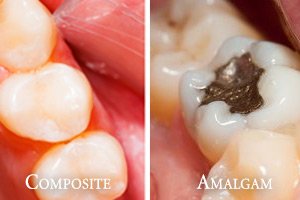Composite vs Amalgam Fillings

Composite vs Amalgam Fillings
Composite fillings, also known as “tooth-colored fillings”, are composed of plastic and silicon dioxide (glass), and require layering the material and hardening it between each application. After the final layer is completed, the resin will need to be shaped to match the tooth, and then polished for a stain and wear-resistant finish.
Amalgam fillings are what we know as “silver fillings” and can be placed with one application. To make dental amalgam, mercury is combined with an alloy of silver, tin and copper which produces a highly effective material for filling the decayed portion of a tooth.
Dr. Carol Jin, DDS in San Ramon, CA is a mercury-free dentist. Amalgam fillings are not particularly pleasing to the eye, and we know that by unavoidable design, mercury fillings ultimately result in a weaker tooth structure.
The Benefits Of Each Material
Composite resin has gained popularity as a material for filling cavities, in addition to its application in restoring cracked, chipped and worn teeth. Because of its chemical composition, it actually bonds with teeth, which provides additional support for the tooth itself, protecting it from further damage and temperature sensitivity. Perhaps one of the biggest appeals of composite fillings is their subtlety. The resin can be matched to an individual’s existing tooth color, which presents a seamless, natural look.
Amalgam fillings are somewhat easier to apply and cheaper on the pocket book, and most insurance companies cover a higher percentage of the cost for amalgam fillings.
The Disadvantages
Composite fillings are slightly more expensive compared to amalgam fillings, but for many people the money is well spent as a means to avoid an unsightly filling that stands out in appearance from the surrounding teeth. The process is also slightly more involved – and for those who are dislike extended chair time at the dentist, the extra 20 minutes can be a deal breaker. Depending on the location and exposure to extreme pressure or wear, the composite material can also chip off the tooth.
Dental amalgam is far from discreet, as silver fillings are quite visible. In addition to its natural metallic color, the material can also discolor the surrounding tooth, turning it a gray tone. To provide enough space for the amalgam to properly fill a cavity, portions of healthy teeth may need to be removed and this can cause issues and gum deterioration.
Lastly, amalgam also expands and contracts more with temperature changes and this action can cause teeth to crack and fracture causing pain and discomfort.



